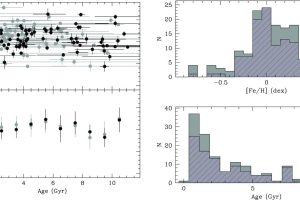There is no relation between age and metallicity of the stars in the Solar neighbourhood. The study: “Constraining the solar neighbourhood age-metallicity relation from white dwarf-main sequence binaries” of A. Rebassa-Mansergas (Universitat Politècnica de Catalunya) recently appeared on MNRAS

After the Big Bang, the Universe contained only hydrogen, helium, and a very small fraction of lithium. After that, stars, mainly the most massive ones, were responsible for the chemical enrichment of the Universe. In fact, stars produce energy by synthetizing chemical elements in their cores. These elements are then redistributed in the interstellar medium when stars end their evolution. As a consequence, the first stars formed in the Universe from a medium of hydrogen and helium, while stars formed later are richer of heavy elements. It is intuitive, then, that it can exist a relation between the age of the stars and their content of heavy elements, called “metallicity”.
Such a relation may offer a great opportunity to measure stellar ages, which is often a very hard task. The age of stars not belonging to stellar clusters is often deduced from the intensity of their magnetic activity or from the comparison between observed colors and magnitudes with values predicted by stellar evolutionary models. Both methods, however, often result in very large uncertainties. More recently, a technique called “asterosysmology”, which consists in measuring stellar internal oscillations, offers more precise age measurements. This technique, however, can only be applied to bright stars for which there exist long and mostly not interrupted photometric monitoring.
In order to verify the validity of the age-metallicity relation, a team of researchers led by the astronomer A. Rebassa-Mansergas (Departament de Física, Universitat Politècnica de Catalunya) have studied a sample of binary systems formed by a white dwarf and a main sequence star. In these systems, in fact, it is possible to obtain reliable estimates of both age and metallicity. The age of the system can be deduced by summing the age of the white dwarf and the evolutionary time of its progenitor (which is the star from which the white dwarf formed). The age of the white dwarf is estimated from its luminosity, by assuming a well-known relation between age and luminosity in these objects which is deduced from their cooling processes. The evolutionary time of the progenitor is instead deduced from its mass, which is estimated from the mass of the white dwarf. Metallicity is instead measured directly from spectroscopic observations of the main sequence star in the system, assuming that it is representative of the system and that no mass transfer occurred during the evolution of the binary system. For the latter assumption, no close binaries were analyzed in this study. The final sample counts 135 systems selected from the Sloan Digital Sky Survey (SDSS) and the second Gaia data release. Spectroscopic observations of these systems were then obtained with different telescopes. The study does not support the existence of a relation between the age and the metallicity of the systems. In the metallicity vs. age plane, in fact, the metallicity distribution obtained by the authors is almost flat and centered on 0, with a one order of magnitude spread. The study is described in the paper: “Constraining the solar neighbourhood age-metallicity relation from white dwarf-main sequence binaries“, recently appeared on the journal Monthly Notices of the Royal Astronomical Society. The astronomer J. Maldonado of the Astronomical Observatory of Palermo is one of the coauthors of the study.
The image (click here to visualize the entire figure) shows the age-metallicity relation obtained in this study. Black points include only age estimates with an uncertainty smaller than 30%. No relation between age and metallicity is observed. In the bottom-left panel ages are sampled in 1 Gyr bins. The right panels show the distributions of both age and metallicity separately, with the distribution obtained from the systems selected from Gaia marked in magenta.
Mario Giuseppe Guarcello ( follow mguarce) ( youtube)
Subscribe the Youtube channel of the Astronomical Observatory of Palermo
